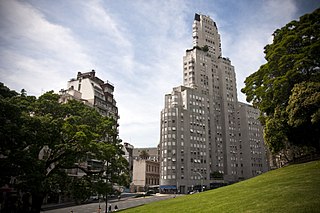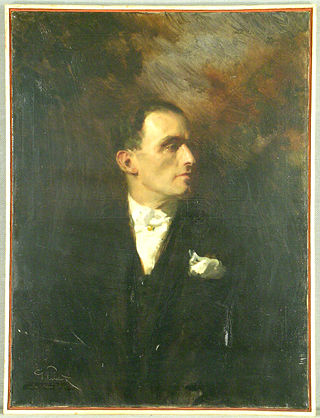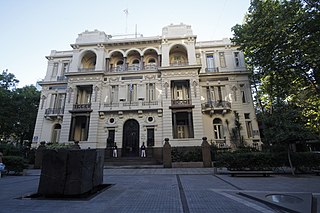
Montevideo is the capital and largest city of Uruguay. According to the 2011 census, the city proper has a population of 1,319,108 in an area of 201 square kilometers (78 sq mi). Montevideo is situated on the southern coast of the country, on the northeastern bank of the Río de la Plata.

Florida Street is a popular shopping street in Downtown Buenos Aires, Argentina. A pedestrian street since 1971, some stretches have been pedestrianized since 1913.

Recoleta is a barrio or neighborhood of Buenos Aires, Argentina, located in the northern part of the city, by the Río de la Plata. The area is perhaps best known to be the home of the distinguished Recoleta Cemetery. It is a traditional upper-class and conservative neighborhood with some of the priciest real estate in the city, known for Paris-style townhouses, lavish former palaces and posh boutiques.

Retiro is a barrio or neighborhood in Buenos Aires, Argentina. Located in the northeast end of the city, Retiro is bordered on the south by the Puerto Madero and San Nicolás, and on the west by the Recoleta.

The Kavanagh Building is a residential skyscraper in Retiro, Buenos Aires, Argentina. Designed in 1934 by architects Gregorio Sánchez, Ernesto Lagos and Luis María de la Torre, it is considered a pinnacle of modernist architecture. At the time of its inauguration in 1936, the Kavanagh was the tallest building in Latin America surpassing the Palacio Salvo built in Montevideo, Uruguay in 1928, as well as the tallest building in the world with a reinforced concrete structure.

Palacio Salvo is a building at the intersection of 18 de Julio Avenue and Plaza Independencia in Montevideo, Uruguay. It was designed by the architect Mario Palanti, an Italian immigrant living in Buenos Aires, who used a similar design for his Palacio Barolo in Buenos Aires, Argentina. Finished in 1928, Palacio Salvo stands 100 m (330 ft) high with the antenna included. It was the tallest building in Latin America for a brief period.

The architecture of Argentina can be said to start at the beginning of the Spanish colonisation, though it was in the 18th century that the cities of the country reached their splendour. Cities like Córdoba, Salta, Mendoza, and also Buenos Aires conserved most their historical Spanish colonial architecture in spite of their urban growth.

According to the World Travel & Tourism Council (WTTC) the travel and tourism sector of Argentina was moving towards recovering its pre-covid pandemic contribution to GDP in mid-2023, led by Buenos Aires.

Uruguayan tango is a rhythm that has its roots in the poor areas of Montevideo around 1880. Then it was extended to other areas and countries. As Borges said: "...tango is African-Montevidean [Uruguayan], tango has black curls in its roots..." He quoted Rossi, that sustained that "...tango, that argentine people call argentine tango, is the son of the Montevidean milonga and the grandson of the habanera. It was born in the San Felipe Academy [Montevideo], a Montevidean warehouse used for public dances, among gangsters and black people; then it emigrated to underworld areas of Buenos Aires and fooled around in Palermo's rooms..." This also implies that different forms of dance were originated in the neighborhoods of Montevideo, Uruguay in the last part of the 19th century and in the early 20th century that was particular from that area and different from Buenos Aires. It consists of a variety of styles that developed in different regions of Argentina and Uruguay.

Mario Palanti was an Italian architect who designed important buildings in the capital cities of both Argentina and Uruguay.

Torre Aqualina is a high-rise residential building completed in 2009 in Rosario, province of Santa Fe, Argentina. It is located on the corner of San Luis and Alem Streets, in Barrio Martín, a few blocks south of the National Flag Memorial.

The Legislative Palace of Uruguay is a monumental building, meeting place of the General Assembly of Uruguay, and the seat of the legislative branch of the Uruguayan government. It is located in the Aguada neighborhood of Montevideo.
There are many landmarks in Buenos Aires, Argentina some of which are of considerable historical or artistic interest.

The Renoir Towers are two residential towers currently under development in the Puerto Madero neighborhood of Buenos Aires, Argentina.

Sofitel Buenos Aires is a five star hotel in the Retiro section of Buenos Aires.

The Piria Palace is the headquarters of the Supreme Court of Uruguay. Located on the south side of the Plaza de Cagancha in Montevideo, on the Human Rights Passage, it was declared a National Historical Monument in 1975. In front of its main entrance is the Monument to Justice, a work by Rafael Lorente Mourelle.

Nelly María Hunter, better known by her stage name Nina Miranda was a Uruguayan tango singer and composer who settled in Argentina in the early 1950s. She is known for the songs, "Maula", "Garufa", "Mamá, yo quiero un novio", "La tigra", and the popular "Fumando espero".






























